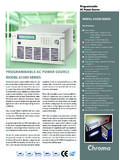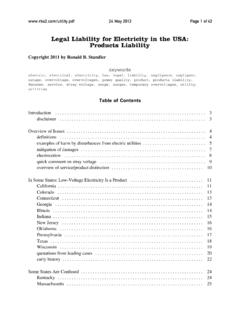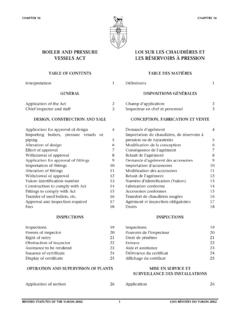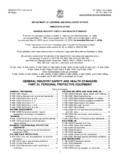Transcription of The Hydro Turbine Governor Tutorial - IEEE Canada
1 The Hydro Turbine Governor and Why it is Important to Understand it by John Codrington, P. Eng. Hatch Inc., Niagara Falls, Ontario ( ) An overview of the Hydro Turbine Governor will be given. The idea of the Governor was first treated analytically by Clark Maxwell in the 19th century. Governor action was correctly seen as something very important in the days when Hydro plants were installed as the sole or the principal contributor to a small power system. As large interconnected systems developed, the large number of loads and generators obscured the action of the Governor . Less interest was taken in how the Governor should be specified and adjusted for use in a large interconnected system. However, mysterious power flows began to be seen in generation areas where the generation was predominantly Hydro . This led to Governor setting policies, which are valid today. Now, we have the ability to build very large computer models and to demonstrate the significance of the Governor .
2 In addition, it has been demonstrated that the computer models may indicate that a system is robust, while real life experience shows that the system has collapsed. This anomaly has been explained by inadequate representation of the Hydro Turbine and its Governor . It is now a requirement of the System Operator that Hydro power plant owners submit data that will allow realistic models to be developed for inclusion in system models. This Tutorial is intended to prepare engineers, as well as practitioners of other profiles and students interested in the Hydro power generation, to understand the operation of Governor and to describe the control system and the Hydro Turbine Governor control parameters. John Codrington received his (Hons) in Mechanical Engineering from University of Manchester, England in 1964. He has been with Acres, and now Hatch Energy, for 43 years and has contributed to many different projects.
3 His most recent experience has been in hydroelectric engineering, much of this being in Latin America and Iran. He made a major contribution to the conceptual work and was responsible for the specifications for the Pelton turbines and the gates for the San Gaban hydroelectric project, Peru. He contributed to a proposed high head Pelton station in Guatemala, making recommendations to deal with hydraulic transients. He was more recently assigned overseas to work on the 2000 MW Karun III project in Iran, where he was responsible for the design review of all mechanical equipment including the Francis turbines, the governors, the gates in the high head arch dam, and other equipment in the powerhouse. He participated in the shop testing of the Governor , where a feedforward algorithm requested in the specifications was coded in and successfully tested in the course of the shop testing. He has participated in studies dealing with dynamic problems and frequency regulation at a hydroelectic plant supplying a mining and smelting operation in Indonesia.
4 He has a strong background in analysis of transients in pumping installations and Hydro plants. He prepared a computer model to investigate the dynamic behaviour of the interconnected electrical system following a proposed intertie between Kenya and Tanzania. This model was focussed on prime mover control and investigated how the system and the proposed tie lines responded to load changes. Mr. Codrington prepared technical specifications and participated in procurement of Hydro Turbine Governor systems for major projects such as Churchill Falls, Labrador, Akosombo in Ghana, and Karun III in Iran. In each of these cases, special demands were made on the Governor systems and special features were specified. He recently participated in studies for the Blue Lake project for the City of Sitka, where a preliminary surge tank configuration was developed and estimates were made of the local power system frequency response to load demand changes.
5 A customized computer model was prepared to analyze the response of the electrical system to demand changes. Mr. Codrington is a registered Professional Engineer in the province of Ontario, and a Life Member of the American Society of Mechanical Engineers (ASME). Related Representative Publications Hydroelectric Turbine Regulation Criteria , Presented at ASME Winter Annual Meeting, Anaheim, California, Publication FED-Vol. 136, November 1992. Computer Representation of Electrical System Interaction with a Hydraulic Turbine and Penstock , Joint Power Generation Conference, St. Louis, Missouri, 1981. (Coauthor) The Use of Impedance Concepts and Digital Modelling Techniques in the Simulation of Pipeline Transients , Presented at the 2nd International Conference on Pressure Surges, London, England, September 1976. (Coauthor)






